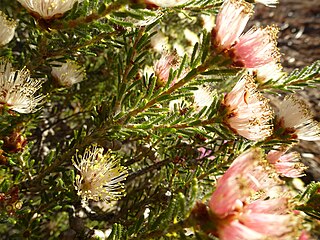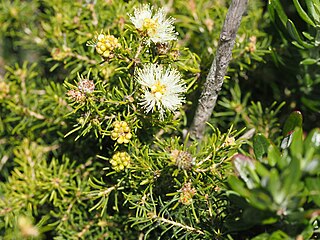
Melaleuca trichophylla is a shrub in the myrtle family, Myrtaceae, endemic to the south-west of Western Australia. Its pink or purple flowers appear from August to December in its native range. It has long been cultivated.

Melaleuca clavifolia is a plant in the myrtle family, Myrtaceae and is endemic to the south-west of Western Australia. It is a small shrub similar to Melaleuca tinkeri, with "pom-pom" heads of pinkish flowers and soft, silky hairs on the new growth but it has larger flower heads and its leaves are shorter, more club-shaped and have less distinct oil glands.

Melaleuca eurystoma is a plant in the myrtle family, Myrtaceae and is endemic to the south of Western Australia. It is a small shrub with pale lemon to greenish flowers and egg-shaped to almost oval leaves.
Melaleuca eximia is a plant in the myrtle family, Myrtaceae and is endemic to the south of Western Australia. It is distinguished by its leaf arrangement, its large, showy red inflorescences and the large, furry bracts under the flowers.

Melaleuca laetifica is a plant in the myrtle family, Myrtaceae and is endemic to the west coast of Western Australia. It has unusual warty, hairy leaves and heads of bright yellow flowers in spring. It is one of the brightest yellow flowering melaleucas and deserves a place in gardens in semi-dry to temperate areas.
Melaleuca lara is a plant in the myrtle family, Myrtaceae and is endemic to a small area on the west coast of Western Australia. It is similar to Melaleuca ciliosa with its hairy young leaves and heads of yellow flowers ageing to red but there are fewer flowers in each head and the leaves are generally smaller.

Melaleuca leuropoma is a plant in the myrtle family, Myrtaceae and is endemic to the south-west of Western Australia. It is a small to medium-sized shrub which flowers over an extended period with flower colour varying from purple to yellow or white. The glossy, often brown petals covering the flower buds are also an unusual characteristic of this species.

Melaleuca systena, commonly known as coastal honeymyrtle is a plant in the myrtle family, Myrtaceae and is endemic to the south-west of Western Australia. It was previously known as Melaleuca acerosa. It is a small shrub with crowded foliage and profuse heads of white to yellow flowers on the ends of its branches in spring.

Melaleuca wonganensis is an erect shrub in the myrtle family Myrtaceae and is endemic to the south-west of Western Australia. It is a shrub with narrow leaves and purple to deep mauve flowers and is restricted in its distribution to the Wongan Hills district.

Melaleuca zonalis is a shrub in the myrtle family Myrtaceae and is endemic to the south-west of Western Australia. It is a shrub with several stems, mostly spoon-shaped leaves and usually pale yellow flowers which age to pink. Whilst it is common, it is restricted to a relatively small area.

Melaleuca urceolaris is a low, spreading shrub in the myrtle family Myrtaceae and is endemic to the south-west of Western Australia. Although it is rare in cultivation, it is an attractive garden plant due to its soft foliage and white flowers which fade to pink or red. It is similar to Melaleuca scabra with which it has often been confused.

Melaleuca leiocarpa, commonly known as pungent honey-myrtle, is a plant in the myrtle family, Myrtaceae and is native to arid areas in parts of South Australia and Western Australia. It is an erect or branching shrub distinguished by its prickly foliage, yellowish flowers and, for a melaleuca, unusually large, smooth, roughly spherical fruits.

Melaleuca ciliosa is a small shrub in the myrtle family, Myrtaceae and is endemic to the south-west of Western Australia. It has bright or pale yellow flowers, an unusual calyx and leaves that are slightly hairy, especially around the edges.
Melaleuca fissurata is a plant in the myrtle family, Myrtaceae and is endemic to the south-west of Western Australia. It is a shrub with rough bark, dished leaves and heads of white or yellow flowers in spring. It is closely related to Melaleuca lateriflora but differs from it in having roughly textured, corky fruit and shorter, convex shaped leaves.
Melaleuca manglesii is a plant in the myrtle family Myrtaceae and is endemic to a small area in the south-west of Western Australia. It is a low, spreading shrub which produces large numbers of heads of purple flowers with yellow tips in spring.
Melaleuca oldfieldii is a plant in the myrtle family, Myrtaceae, and is native to the south-west of Western Australia. It is distinguished by its bright yellow flower heads but its distribution is restricted to one national park.

Melaleuca polycephala is a shrub in the myrtle family, Myrtaceae, and is endemic to the south-west of Western Australia. It is a sparsely foliaged, twiggy shrub with deep purple flowers in spring.

Melaleuca psammophila is a plant in the myrtle family, Myrtaceae, and is endemic to the south-west of Western Australia. It is a small shrub with narrow leaves, heads of purple, pink or mauve flowers and clusters of woody fruit. It is similar to M. bisulcata but differs from that species in characters such as the shape of its fruit, leaves and buds but like that species is an attractive, profusely flowering shrub suitable for cultivation as a garden plant.

Melaleuca subtrigona is a plant in the myrtle family, Myrtaceae, and is endemic to the south-west of Western Australia. It is a small shrub with warty leaves and heads of "pom-pom" flowers in spring and early summer.

Melaleuca thymoides is a plant in the myrtle family, Myrtaceae, and is endemic to the south-west of Western Australia. It is usually a low shrub. The ends of the branches usually end in a sharp spine and the leaves also have a sharp point. Bright yellow flowers appear on the ends of the branches in spring or early summer.















